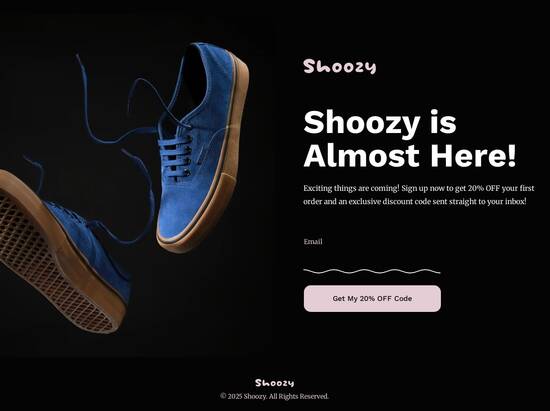
Intuitive cancellation page template
Explore Similar TemplatesAbout template
Unleash your creativity with the intuitive cancellation page template. Try Instapage today.
Recommended templates

Easy to build without coding
With the intuitive drag-and-drop builder, anyone on your team can create high-converting pages without any knowledge of code or design. Make enhancements to your landing page with custom widgets using Javascript, HTML/CSS, or third-party scripts.

Multiple layouts for any industry and goal
Select from 500+ landing page layouts built to boost conversions across industry-specific scenarios. Customize them by adjusting fonts, adding images, and generating on-brand content with the AI assistant. Quickly scale with Instablocks® and Global Blocks that you can save, reuse, and update globally.

Loads fast and looks polished on any device
Every template is responsive, which means they present professionally on any device and load blazingly fast with our Thor Render Engine. You can also power them up with Google AMP technology to deliver an unparalleled mobile experience and drive higher conversions.

Robust analytics & experimentation
Get real-time updates and reporting across all your devices, showing the number of visitors, conversions, cost-per-visitor, and cost-per-lead. Launch AI-powered experiments, run A/B tests, and use heatmaps to analyze user behavior, then optimize your landing page to maximize conversions.







Easy to build without coding
With the intuitive drag-and-drop builder, anyone on your team can create high-converting pages without any knowledge of code or design. Make enhancements to your landing page with custom widgets using Javascript, HTML/CSS, or third-party scripts.
Multiple layouts for any industry and goal
Select from 500+ landing page layouts built to boost conversions across industry-specific scenarios. Customize them by adjusting fonts, adding images, and generating on-brand content with the AI assistant. Quickly scale with Instablocks® and Global Blocks that you can save, reuse, and update globally.
Loads fast and looks polished on any device
Every template is responsive, which means they present professionally on any device and load blazingly fast with our Thor Render Engine.
Robust analytics & experimentation
Get real-time updates and reporting across all your devices, showing the number of visitors, conversions, cost-per-visitor, and cost-per-lead. Launch AI-powered experiments, run A/B tests, and use heatmaps to analyze user behavior, then optimize your landing page to maximize conversions.
All the features you need to build cancellation list template excel
Explore more featuresLearn how to build cancelation list template
FAQs
Leading the way in building high-performing landing pages





An intuitive cancellation page template to enhance user experience
Creating an intuitive cancellation page is essential for retaining customer trust even as they choose to cancel their subscriptions. With Instapage's powerful landing page features, marketers can design cancellation pages that guide users through the process while reinforcing a positive brand experience. This step-by-step guide will outline how to construct a cancellation page that mitigates churn and enhances customer relations.
Understanding the need for an intuitive cancellation page
An effective cancellation page can significantly impact your overall customer retention strategy. Instead of simply offering a way to unsubscribe, consider this page as an opportunity to gather valuable feedback and potentially convert cancellations into future engagement. The following are crucial components to consider:
- Clear Messaging: Ensure that users understand why they are being asked to leave. Use concise language that respects their choice while inviting them to share feedback.
- Feedback Options: Integrate a simple form that allows users to express their reasons for cancellation, which can provide insights for your marketing team.
- Re-engagement Offers: Consider offering promotions or incentives to encourage users to reconsider their decision, such as discounts or extended trials.
Step 1: Craft compelling messaging
The first step in building your cancellation page is to develop messaging that reflects empathy and understanding of your users' choices. Here’s how to communicate effectively:
- Acknowledge Their Decision: Start by thanking them for their previous engagement with your service, recognizing that their time is valuable.
- Reinforce Brand Value: Remind users of the benefits they received during their subscription, which may resonate with their reasons for leaving.
- Invite Feedback: Encourage users to let you know why they are canceling to better understand customer sentiment and improve your offerings.
Step 2: Incorporate user feedback tools
Integrate a feedback tool to provide users with a seamless way to express their reasons for leaving. This data can provide valuable insights for future marketing strategies.
- Short Surveys: Use a brief survey that asks users to select their cancellation reason from a few predefined options, like cost or service satisfaction.
- Open Text Box: Allow users to type in custom responses, further enriching the feedback pool.
- Anonymous Feedback: Ensure confidentiality to make users feel more comfortable sharing their true opinions.
Step 3: Explore re-engagement strategies
Finally, consider implementing methods to potentially win back those users as they exit. Integration of incentives can be powerful here:
- Discount Offers: Provide an immediate coupon or promotional offer for users who may consider returning later.
- Service Upgrades: Inform users about potential service upgrades or features that could enhance their experience, addressing issues they might have faced.
- Follow-Up Communications: Assure users that they can reconnect easily and engage with the brand later through targeted campaigns.
In conclusion, designing an intuitive cancellation page can help marketers keep the lines of communication open with exiting users. By crafting clear messaging, inviting feedback, and proposing re-engagement strategies, brands can reduce churn rates and cultivate a positive user experience.
Ready to create your intuitive cancellation page? Sign up for Instapage today to access customizable templates and optimize your campaigns seamlessly.
People also ask about Intuitive cancellation page template
Understanding intuitive cancellation page templates
The evolution of cancellation pages in the digital age
Cancellation pages have undergone significant transformations throughout the years, evolving from basic, sometimes confusing interfaces to more thoughtful, user-centric designs. Initially, many platforms treated cancellation as a mere afterthought, often comprising a simple 'Are you sure?' prompt. This approach often resulted in frustration for users and a missed opportunity for businesses to understand customer needs better. As businesses have become more aware of user experience principles, the importance of a well-designed cancellation page has become clear.
From being merely utilitarian, cancellation pages now play a vital role in customer retention strategies. They have shifted from being a final goodbye to an opportunity for feedback, offering alternatives that can possibly retain the customer. A well-thought-out cancellation page can not only provide a smoother exit for users but also gather valuable insights that can guide future business strategies. Ultimately, the design and approach taken on these pages can make all the difference in enhancing user experience.
The psychology of cancellation: understanding user behavior
To effectively design cancellation pages, it's essential to understand the psychology behind user cancellations. Many users choose to cancel their subscriptions due to various reasons such as financial constraints, lack of use, or finding better alternatives. Recognizing these motivations is crucial for businesses to not only address the reasons but to innovate their offerings based on customer feedback. By understanding emotional triggers such as frustration or disappointment, brands can adapt their cancellation pages to provide a more sympathetic experience.
Incorporating empathy into the cancellation process can be a powerful strategy. When users feel acknowledged and understood, they are more likely to respond positively, potentially reconsidering their decision. By appealing to emotions and highlighting how their needs can still be met, businesses can transform cancellations into constructive dialogues rather than one-sided exits. This empathetic design approach can effectively reduce churn rates and create lasting customer relationships.
Key features of intuitive cancellation page templates
An intuitive cancellation page template should incorporate various features to create a seamless user experience. Given the emotional nature of cancellations, user-friendly design must be prioritized, ensuring easy navigation and accessibility. Companies can benefit from focusing on four primary elements within their cancellation page templates.
User-friendly design for seamless navigation
A straightforward layout simplifies user interaction, encouraging users to exit gracefully without confusion.
Dynamic form integration for customization
Cancellation forms should adapt to user inputs to provide a tailored experience, reflecting individual reasons for cancellation.
Effective messaging strategies for retention
Compelling and empathetic messaging can persuade users to reconsider their cancellations by offering them alternatives.
Personalization techniques in cancellation pages
Utilizing user data allows businesses to tailor cancellation experiences, enhancing perceived value.
Building an engaging cancellation experience
To transform the cancellation process into a positive experience, storytelling can play a pivotal role. Sharing success stories from other users who once considered canceling but chose to stay can create emotional connections. This narrative can highlight how challenges were overcome and showcase the benefits that can still be gained from the service. An engaging narrative framework can dissuade users from leaving and turn cancellations into discussions about improvement.
Moreover, incorporating visual elements such as graphics or videos can further enhance engagement. A well-crafted video explaining updates, features, or even a personal message from the company’s team can humanize the experience. These enhancements not only support user engagement but can also foster a sense of community, encouraging users to invest more in their relationships with the brand even as they consider leaving.
Designing for retention: the role of plans and membership options
An essential element of a cancellation page is the ability to present alternative plans effectively. Users may cancel because they believe a different plan better suits their needs. Therefore, intuitive templates should display this information prominently, showcasing upgraded or alternative memberships during the cancellation process. This approach can create opportunities for retention by emphasizing value and flexibility.
Understanding the right moment to present these alternatives is equally important. Behavioral triggers, such as repeated cancellations, feedback forms indicating dissatisfaction, or usage patterns that suggest disinterest, can guide businesses in presenting alternatives at the right time. The more relevant and opportune the intervention, the better the chances of keeping users engaged.
Measuring the impact of cancellation pages on churn rates
To optimize cancellation page templates, monitoring their effectiveness is crucial. Businesses should track key metrics such as abandonment rates, overall user satisfaction, and feedback to understand how users interact with cancellation pages. By analyzing these metrics, companies can determine which elements are working and identify areas for improvement, ensuring a tailored approach to user experience.
Industry-specific tools can assist in this analysis, offering insights into user behavior during the cancellation process. By utilizing heatmaps to visualize interactions, businesses can pinpoint specific design challenges and iterate their templates accordingly. Continuous improvement through data-driven strategies can significantly reduce churn while ensuring users feel valued even in the cancellation process.
Best practices for optimizing cancellation templates
For businesses aiming to enhance their cancellation page templates, several best practices should be integrated. These practices not only guarantee user satisfaction but also promote retention strategies that can sustain business relationships.
Essential elements to include
Every cancellation page should have clear navigation, options for alternative plans, empathetic messaging, and feedback opportunities.
Common pitfalls to avoid
Avoid overly complex forms, negative language, and failing to acknowledge user feedback.
A/B testing strategies
Regular testing of different designs and messaging can provide insights into user preferences and improve conversion rates.
Adapting the cancellation experience across different apps
When designing cancellation processes, it's essential to tailor approaches based on the type of app. For instance, SaaS platforms typically require users to consider several factors like costs, usability, and ongoing needs, while e-commerce applications may focus on returns and purchase experiences. Each platform demands a nuanced understanding of the user’s needs and preferences.
Understanding user demographics also plays a critical role. Different age groups, income levels, and market positions influence user behavior, necessitating a tailored approach for cancellation processes. Businesses should consider these factors to create cancellation pages that resonate with their unique user bases.
Real-life implementations of intuitive cancellation pages
Businesses that have effectively transformed their cancellation pages offer valuable insights. For example, a case study of a SaaS company illustrates how they redesigned their cancellation forms. They moved from a generic form to a personalized, user-driven experience that captured feedback and offered alternatives based on user profiles. This redesign not only reduced churn by 20% but also improved customer satisfaction.
In another instance, an e-commerce brand integrated engaging story-driven content into their cancellation process. Providing customers with testimonials on successful returns and positive outcomes not only connected emotionally but also encouraged users to reflect before proceeding with cancellations. These stories and user-focused approaches have led to a decrease in the overall cancellation rate and an increase in overall brand loyalty.
The future of cancellation pages: trends and predictions
Technology will continue to play a pivotal role in shaping cancellation experiences. With advances in AI and machine learning, future cancellation pages may offer more personalized experiences based on user interactions and preferences. These developments could entail deeper insights into the factors driving cancellations, enabling businesses to enhance customer relations and reduce churn rates effectively.
Emerging trends suggest that user expectations will evolve. Customers will likely demand more transparency and instantaneous responses during the cancellation process. Brands that can seamlessly integrate these needs into their cancellation templates will not only provide a better user experience but will also turn potential exits into opportunities for dialogue.
The role of support in the cancellation process
Customer support is integral to shaping cancellation journeys. Offering immediate assistance via live chat or automated support not only provides users with answers but also gives them a sense of connection to the brand. When users feel supported, they are more likely to reconsider their cancellation decision, especially if they perceive that the brand values their concerns and needs.
Moreover, direct interactions allow businesses to delve deeper into cancellation motivations, gathering valuable feedback that can enhance offerings and improve user experiences. Therefore, integrating effective support options into cancellation pages is crucial for fostering relationships and minimizing potential churn.
Conclusion: transforming the cancellation experience
In summary, implementing intuitive cancellation page templates can transform what was once a frustrating task for users into an opportunity for reflection and engagement. A well-designed cancellation page that emphasizes understanding, empathy, and support can significantly reduce churn rates while fostering a sense of community and connection between the user and the brand.
As businesses continue to innovate, incorporating user feedback into their ongoing design processes becomes imperative for refining cancellation experiences. This attention to user needs not only improves cancellation outcomes but can also cultivate valuable learning opportunities that drive brand loyalty.
Final thoughts on utilization and innovation
Businesses should welcome the opportunity to innovate their cancellation strategies. As an essential aspect of the user experience, cancellation pages serve not just as exits, but as vital touchpoints for learning and improvement. By considering the factors discussed in this article, companies can craft cancellation pages that deliver positive experiences, maintain user connections, and support ongoing growth.
Ready to skyrocket conversions?
Supercharge your ad campaigns with high-performing landing pages
Get started














